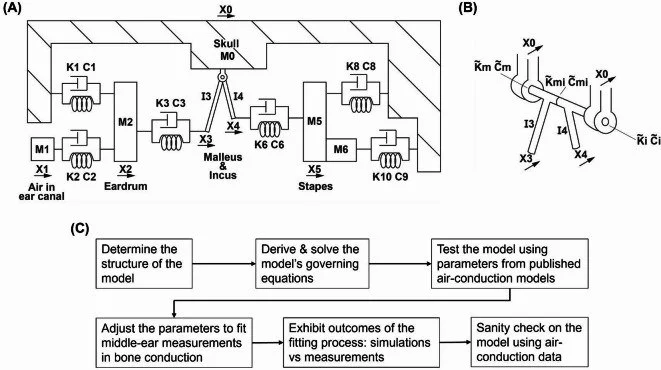Detailed 3D reconstruction and analysis of the inner ear are now, for the first time, providing insights into volume changes of inner ear structures in people who have Ménière's disease. Ménière’s disease is a rare chronic inner ear disorder affecting balance and hearing. Though the exact causes of Ménière’s disease are not precisely known, symptoms are believed to arise from the buildup of fluid (hydrops) in chambers of the inner ear, creating pressure.
A collaboration between the Karl Landsteiner University of Health Sciences, in Krems, Austria, Harvard Medical School, and Johns Hopkins University provides new insights, published in Otology & Neurotology in July 2023. The team includes Bryan K. Ward, M.D., a 2020 Emerging Research Grants scientist at Johns Hopkins University School of Medicine.
Using 3D reconstructions of inner ears, the team was able to measure for the first time altered volumes of endolymphatic compartments, fluid-filled sacs, in patients with the disease. The team also identified a connection with the thickness of special membranes in the inner ear. In addition, further evidence was found concerning the functioning of a poorly understood structure in the inner ear called Bast’s valve.
The balance organs the saccule and utricle are fluid-filled compartments at the outer end of the cochlear duct. In the study, the team compared the inner ear of nine Ménière's patients with those of 10 healthy individuals. They created digital 3D models based on numerous anatomical slices. These were then used to determine the volumes of the endolymphatic compartments as well as the thickness of membranous labyrinth walls and the condition of Bast’s valve.
A 3D reconstruction of two inner ear fluid spaces and nerves (view from superior). Left: ear with endolymphatic hydrops. Right: unaffected typical ear. White indicates facial nerve; red, cochlear duct; yellow, nerves; green, utricle and semicircular canals (the superior semicircular canals are missing); blue, saccule; lilac, endolymphatic duct and sac; and gray (semitransparent), total bony labyrinth (perilymphatic) space. On the left side, the hydropic saccule distends into the posterior part of the bony lateral semicircular canal. In this case, the volume increases compared with the typical ear are as follows: utricle, 1.2 times; saccule, 7.6 times; cochlear duct, 3.5 times. Credit: Büki, Ward, Santos/Otology & Neurotology
“Very often, the volume of the external cochlear duct as well as the one of the sacculus [saccule] was enlarged in affected patients. We were able to clearly demonstrate this in the virtual 3D models,” study coauthor Béla Büki, M.D., Ph.D., says. Furthermore, the evaluations showed that the volume of the utricle had also increased in some, but not all, affected individuals.
Thanks to the 3D modeling, the study authors were subsequently able to measure the thickness of the membranes lining the respective compartments. "The thickness of this membrane forms a mechanical resistance to the increase in pressure of the inner ear fluids known as endolymph,” Büki says. “This, in turn, affects volume changes.”
And indeed, the membrane thicknesses correlated with the analyzed volumes of the compartments: In healthy subjects, the membranous wall in the utricle was thicker compared with that of the (outer) cochlear canal, as well as that of the saccule—which could prevent an expansion in volume when endolymph pressure is increased. This would explain the observation that the utricle was less frequently dilated in individuals with Ménière’s disease.
The team further analyzed Bast’s valve, located at the entrance to the utricle. In all of the study’s cases of Ménière's disease in which the utricle was also swollen, Bast’s valve was open, or the surrounding membrane was ruptured. This suggests a pressure-regulating function of the valve. This is an invaluable observation because the exact function of this valve has yet to be definitively identified nearly 100 years after its discovery.
Fluid buildup in the saccule and cochlear duct might be due to increased pressure, while the utricle might be better protected due to its thicker walls and functioning valve. This points to an inverse relationship between membrane thickness and fluid buildup, helping us better understand how fluid buildup occurs in Ménière's disease.
This is adapted from a press release by Karl Landsteiner University. A 2020 Emerging Research Grants scientist, Bryan K. Ward, M.D., is an associate professor of otolaryngology–head and neck surgery at Johns Hopkins University School of Medicine. His other research on Meniere’s disease includes an explanation for divergent test results; a historical perspective on surgery; and a historical review of treatments. He is also an accomplished artist; see his artwork here.








Cochlear implants work differently from hearing aids. Instead of making sounds louder, they bypass the damaged parts of the inner ear and send signals directly to the brain, allowing individuals to perceive sound more clearly.